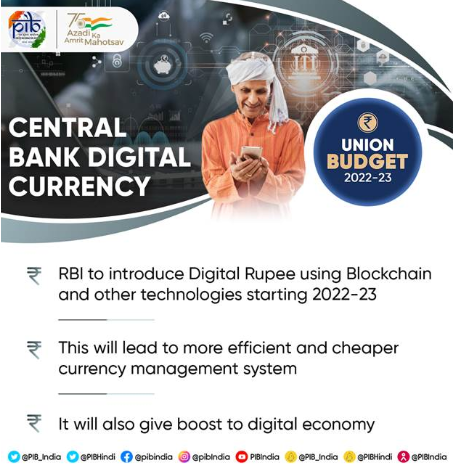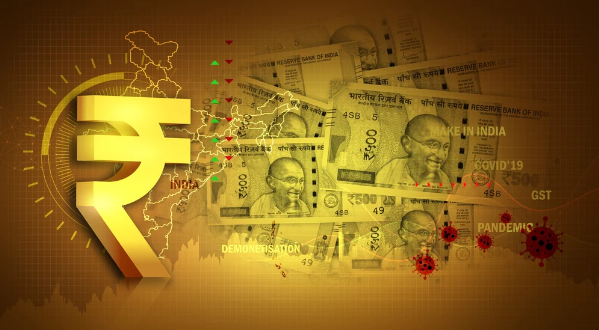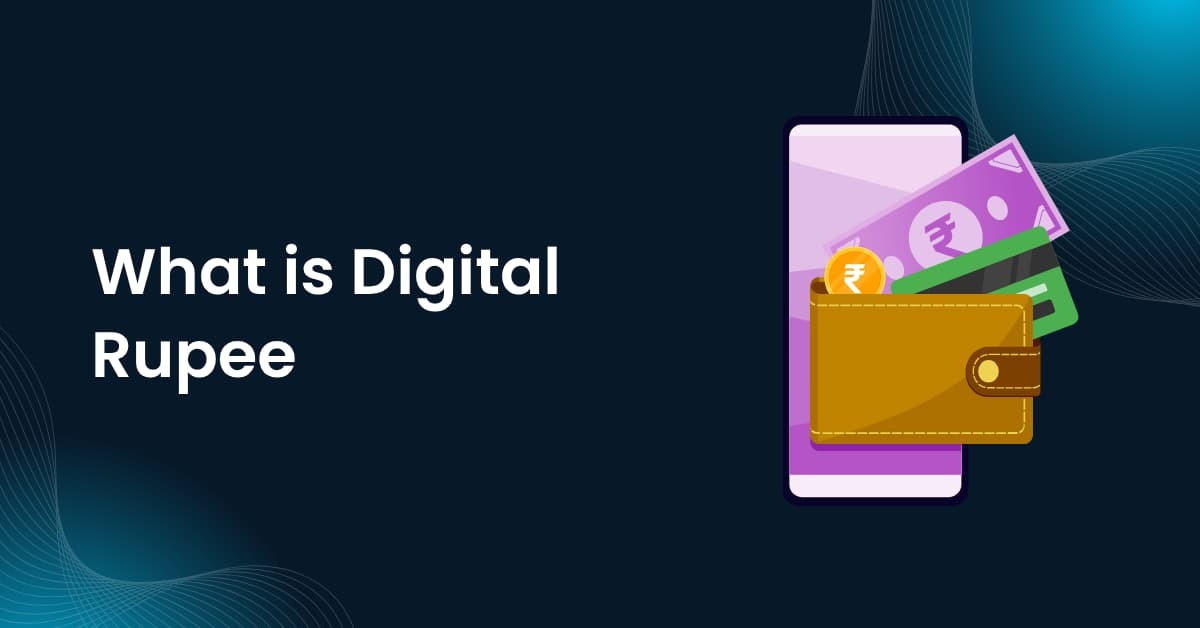Digital Rupee is India’s new form of money from the RBI, made to work like cash but in a secure digital way. It is part of India’s digital currency push to make payments easier.
The pilot for this e-Rupee (e₹) started in December 2022, and people can use it through approved digital rupee wallets, including SBI e-Rupee options.
As an Indian digital currency backed by the central bank, it aims to cut cash costs and give faster payments for daily use.
In this guide, you get a clear idea of what the Digital Rupee is, how it works, and how banks like SBI support this system for regular users.
What Is A Digital Rupee? Quick Answer
The Digital Rupee is a new way for people in India to make payments and store money using secure digital wallets provided by banks.
Here’s the summarized version of Digital Rupee in a table:
| Aspect | Details |
|---|---|
| Official Name | Digital Rupee (e₹) |
| Type | Central Bank Digital Currency (CBDC) |
| Issuing Authority | Reserve Bank of India (RBI) |
| Launch Date | December 2022 (Pilot Phase) |
| Legal Status | Legal Tender |
| Backing | Sovereign guarantee by the RBI |
| Exchange Rate | 1:1 with physical rupee |
The Digital Rupee is given through select banks via digital wallets. Unlike UPI, it allows direct transfers without a bank account.
What Is The Digital Rupee? Detailed Explanation
Central Bank Digital Currency (CBDC), also known as “Digital Rupee” or “e₹”, is defined by the RBI as a legal tender issued by a central bank in a digital form.

Here is the deeper take on the digital rupee:
The Digital Rupee is India’s official digital currency issued by the Reserve Bank of India (RBI). It functions as a legal tender in digital form, just like physical cash, but is stored and transacted electronically.
This digital currency aims to enhance payment efficiency, reduce transaction costs, and promote financial inclusion. Unlike cryptocurrencies, the Digital Rupee is regulated by the central bank, ensuring security and stability.
Users can make instant, secure payments using wallets or apps linked to their bank accounts. Overall, the Digital Rupee represents a modern evolution of money, blending traditional trust with digital convenience.
The Digital Rupee represents a regulated, government-backed alternative that addresses concerns about types of cryptocurrency scams while providing digital payment benefits.
Why Was The Digital Rupee Introduced?
RBI cites cost reduction, boosting payment efficiency, and innovation as key reasons for introducing the Digital Rupee.

Find out why the digital rupee was introduced:
The Reserve Bank of India (RBI) has key objectives for introducing the Digital Rupee, including promoting financial inclusion by offering easy access to digital payments for unbanked and underbanked populations.
It also aims to reduce the reliance on physical cash, which involves significant costs and logistical challenges.
For example, between April 2021 and March 2022, the RBI spent Rs. 4,984 crore on printing currency notes.
By adopting the Digital Rupee, these expenses can be significantly reduced, supporting India’s goal of becoming a cashless economy and strengthening the overall payment ecosystem.
Key Features Of The Digital Rupee
The Digital Rupee comes with several distinctive characteristics that make it unique.

Here are the key features of the Digital Rupee:
- Legal tender status: The Digital Rupee is officially recognized as legal currency and is fully backed by the Reserve Bank of India.
- Bank account independence: Users can send and receive Digital Rupees even without holding a traditional bank account, increasing accessibility.
- Instant settlement: Transactions using the Digital Rupee are processed immediately, ensuring quick and final payment transfers.
- Complete traceability: Every transaction is recorded transparently, allowing for full auditing and reducing the risk of fraud.
- Secure digital wallets: The currency is stored and used through RBI-approved digital wallets, which provide robust security features.
- Offline capability: Future versions will support transactions without internet access, enabling payments in areas with poor connectivity.
- Denominated structure: The Digital Rupee is available in the same denominations as physical cash, making it easy to use and understand.
How Does The Digital Rupee Work?
The Digital Rupee operates by facilitating fast and secure digital payments, backed by the Reserve Bank of India (RBI).
The RBI creates digital tokens representing the rupee’s value using secure blockchain technology, ensuring the currency is safe and reliable.
These digital tokens are distributed to consumers and businesses through banks and authorized intermediaries, making the Digital Rupee widely accessible.
Users store their digital currency in RBI-approved mobile wallet applications, which keep their funds secure and protected.
Payments can be made easily using QR codes, mobile numbers, or direct transfers, providing a convenient way to transact digitally.
The system supports both retail users and large institutions through a two-tier structure: the retail version (e₹-R) for everyday use and the wholesale version (e₹-W) for significant settlements.
To maintain transparency and security, every transaction is verified and recorded on a distributed ledger. This validation process helps build trust in the digital currency and protects users against fraud.
Benefits Of The Digital Rupee
The implementation of the Digital Rupee offers numerous advantages for various stakeholders.

Here are the benefits of the digital rupee:
- Enhanced transaction speed: The Digital Rupee enables instant payment processing, eliminating the delays typically associated with traditional settlement systems.
- Improved security: Digital Rupee transactions are secured using blockchain technology and advanced encryption, ensuring data integrity.
- Reduced operational costs: By reducing the need for printing, storing, and transporting physical cash, the Digital Rupee significantly lowers related expenses.
- Financial inclusion boost: The Digital Rupee offers digital wallets that enable individuals without traditional bank accounts to access and utilize banking services easily.
- Cross-border efficiency: The Digital Rupee streamlines international payments, making them faster and reducing the costs associated with cross-border transactions.
Challenges And Concerns Of Digital Rupee
Despite its advantages, the implementation of the Digital Rupee faces several obstacles.
There is a risk of cybersecurity attacks in the digital rupee, which could target digital wallets or the underlying infrastructure, potentially compromising users’ funds and sensitive information.
Unlike physical cash, which allows for private transactions, digital rupee transactions are recorded and traceable, raising privacy concerns.
Limited infrastructure in rural areas poses significant barriers to adoption, as users require access to smartphones and stable internet connections to facilitate digital transactions.
Additionally, user education requirements and potential disruption to traditional banking systems present implementation challenges.
How To Buy And Use The Digital Rupee?
Getting started with Digital Rupee is straightforward for eligible users. Find out how to buy and use the digital rupee here:
- Download approved apps: Install Digital Rupee wallet applications authorized by the RBI from participating banks.
- Complete registration: Submit the necessary KYC documents and link the wallet to your existing bank account.
- Load digital rupees: Transfer funds from your bank account into the Digital Rupee wallet for spending.
- Make payments: Pay merchants by scanning QR codes or send money to others using their mobile numbers.
- Monitor transactions
Keep track of all payments and receipts through the wallet’s user-friendly interface. - Withdraw funds: Convert your Digital Rupees back into regular bank deposits whenever needed.
According to a latest report by the RBI, the value of Central Bank Digital Currency (CBDC) or e-rupee in circulation jumped to ₹1,016 crore at the end of March 2025 from ₹234 crore in the year-ago period.
While exploring digital currencies, it’s essential to understand the broader landscape.
Digital Rupee vs. Crypto: What’s The Difference?
The Digital Rupee and cryptocurrencies serve different purposes and operate under distinct frameworks, making it essential to know how they compare.
Central Bank Digital Currencies (CBDCs), like the Digital Rupee, are issued and managed by the Reserve Bank of India.
They are officially recognized by the government and aim to provide a secure, stable, and transparent form of digital money for everyday use within the country’s financial system.
Cryptocurrencies such as Bitcoin and Ethereum, on the other hand, are decentralized and not controlled by any central authority.
Questions about the legality of cryptocurrency in India frequently arise, particularly regarding the differences between Central Bank Digital Currencies (CBDCs) and decentralized cryptocurrencies.
Unlike CBDCs, cryptocurrencies are known for their price volatility, limited regulatory acceptance, and use primarily as investment assets rather than everyday payment tools.
Suggested Read:
Conclusion: RBI’s Digital Rupee Is Now India’s Recognized CBDC
The Digital Rupee marks a key step in India’s shift toward a cashless, RBI-backed CBDC ecosystem. Three years after launch, the e₹ in circulation has already reached Rs 1,016.5 crore in 2025, showing clear adoption and growing trust.
Although challenges like privacy, cybersecurity, and infrastructure still need consistent attention, the Digital Rupee continues to offer strong potential for financial inclusion and smoother economic efficiency.
As pilot programs expand and technology improves, now is the right time to follow how the Digital Rupee is shaping India’s digital payment future.
FAQs
You can convert e₹ back to your bank account at any time; this redemption is available 24×7, just like loading funds.
The Digital Rupee is safe and secured by strong cybersecurity measures, and funds are recoverable even if your device is lost.
You can transfer funds between Digital Rupee and a bank account at any time, including outside regular banking hours.
The Digital Rupee functions like cash, meaning it doesn’t generate interest, but you can move it to your bank anytime for interest benefits.
Instant transfers are supported for any user or merchant with an e₹ wallet, with no dependence on banking hours.
